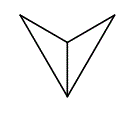| Problem |
Solution |
3) Two congruent isosceles triangles are joined together along a side to create a kite as shown. The perimeter of one of the triangles is 30 units. The lengths of the sides of the triangle are all whole numbers. What is the length of the longest side of the triangle if the perimeter of the kite is as long as possible?

|
Filling out the table results in this:
| Perimeter | Long side length
L | Short side length
S = 30 - 2L |
| 30 | 10 | 10 |
30 | 11 | 8 |
30 | 12 | 6 |
30 | 13 | 4 |
30 | 14 | 2 |
30 | 15 | 0 |
From this table the longest side is 14 units.
|
|
4) Rosie builds a large cube out of sugar cubes. Her large cube has a width of 4 cubes, height of 4 cubes and length of 4 cubes. She wants to add one more layer of cubes all around to make an even larger cube that will have height, width and length 6 cubes. How many cubes does she need?
|
1. The number of small cubes in her 4 x 4 x 4 large cube is 64
2. The number of small cubes in a 6 x 6 x 6 large cube is 216
3. 216 - 64 = 152 additional small cubes.
|
 5) For triangle ABC shown on the coordinate grid what are the coordinates of a 4th point (D) that turns the triangle into a parallelogram?
5) For triangle ABC shown on the coordinate grid what are the coordinates of a 4th point (D) that turns the triangle into a parallelogram?
|
1. Since the desired figure is a parallelogram that means that side BD (with your new point D) is parallel to side CA.
2. Determine the offset in X and Y axes from point C
to get to point A is: [+1,-2]
3. Apply these offsets to point B to get point D = (+5,+5)
See the figure to the left.
|